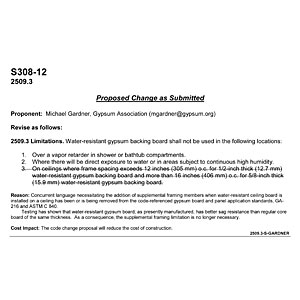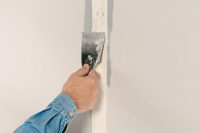Building codes evolve to address changes in how structures are constructed. EIFS, for example, were largely unknown in the United States until the early 1980s. Once the systems achieved broad acceptance, language was placed into model codes to address EIFS materials and application methods.

|
The need to add language to model codes is obvious; the desire to remove language is less apparent. Blame human nature for the latter approach. When faced with an option to remove language (or throw away something we don’t need) the concept that “someone somewhere might want to do it the old way/ I might need it in the future” generally seems to make us reluctant to boot out the old. Even to our detriment.
Sometimes, however, you have to purge the proverbial closet of outdated items. Such is the mind-set that led the Gypsum Association to submit a proposal to remove language from the International Building Code that requires supplemental framing when water-resistant gypsum board (“green board”) is applied to a bathroom ceiling. Current language in Section 2509 requires the ceiling support framing members to which the board is applied to be installed at no more than 12 inches on center for 1/2-inch-thick-green board or 16 inches on center for 5/8-inch-thick green board. A proposal from the Association to delete the language was approved by the voting members of the International Code Council during the October 2012 Final Action Hearings.
TOUGHER TODAY
The historic perception of green board is that it is more susceptible to sag than other board products. While that may have been the instance when it was first introduced in the 1960s, advances in materials science have made today’s contemporary water resistant boards no more or less susceptible to sag than any other gypsum board.
In addition, the humidified deflection values for green board in the 2011 edition of ASTM C1396 are identical to the values for regular wallboard and type X board. Both regular and type X board are commonly applied to bathroom ceilings. Neither requires any supplemental support framing when installed on a ceiling.
The approved proposal, S 308-12, will remove text that has been embedded in code documents and standards for many decades. During the early 1980s, concerns about humid bathroom environments created the impression that green board ceilings could sag disproportionately. The solution for addressing this was to ban the application, and in 1988 the Uniform Building Code was amended to prohibit the use of green board on bathroom ceilings.
For reasons that require little explanation, the gypsum industry was not necessarily supportive of the ban, apparently believing that the problem installations were generally the result of poor application techniques, but grudgingly agreed to have it inserted into the code. Resolution came in 1994 in the form of code language that mandated a closer spacing of framing members when green board is applied on a ceiling.
The supplemental framing language gradually migrated to other codes, and in 2000 it was placed in the first editions of the IBC and the International Residential Code. In the mid-90s, it was incorporated into ASTM C840 and GA-216, the standards referenced by the IBC that define the criteria for the application of green board.
HARD LANGUAGE
Because of improvements to the product manufacturing process, the supplemental framing language was reduced to “gotcha” status that only served to hamstring the contractor. Noting that the language is outdated, the two independent committees with oversight for the ASTM C840 and GA-216 standards each agreed to remove the language from the upcoming edition of each document. To eliminate a discrepancy between the code and the documents it references, the association submitted the code change proposal that was approved. A similar proposal will be submitted to remove similar text from the IRC. NFPA 5000 will be addressed at the next opportunity.
Another proposal submitted by the Gypsum Association and approved during the final hearings corrected an odd situation that can most politely be called an oversight.
For many years, Section 2308.9 of the IBC has listed 1/2-inch-thick gypsum board as a material acceptable for use when structurally bracing an exterior building wall. Oddly, while the prescriptive language lists nail-applied 1/2-inch-thick wallboard as an acceptable bracing material, the language had never been updated to allow the use of 5/8-inch-thick gypsum board or to permit screw fastening of gypsum board when it is used as part of a bracing system.
Confronted by these omissions, association staff authored a proposal to insert 5/8-inch-thick gypsum board and the screw fastening method into the IBC. The approved proposal, S 289-12, was modified slightly in final action by a coordinating proposal submitted by the wood industry. The Gypsum Association agreed with the wood industry proposal and testified in support of the modification.
In retrospect, it is not surprising that the oversight in the IBC language had gone unnoticed for many years. The specific language in the IBC that regulates wall bracing is somewhat disjointed and scattered throughout the code. It is difficult to follow its logic and flow. In addition, while bracing methods are used to construct buildings built to the IBC, they are used more often with residential dwellings constructed to the IRC. And the same language issue does not exist in the IRC.
Neither modification takes effect until the 2015 edition of the IBC has been adopted by the jurisdiction of authority. As noted above, The Gypsum Association will introduce a proposal to remove the supplemental framing language from the 2015 edition of the IRC. The initial hearing process for the proposal will occur in late April 2013 and the Final Action Hearings on the proposal will be in late October 2013. W&C




Report Abusive Comment